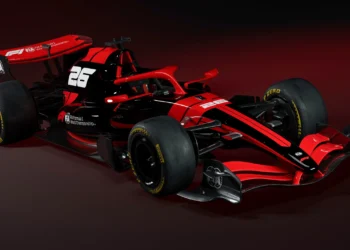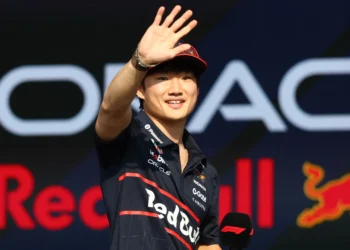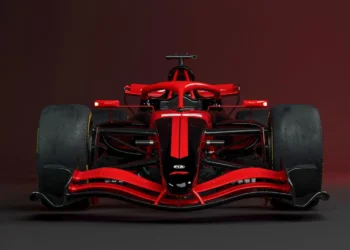In a sport where safety has become the cornerstone of competition, NASCAR’s Next-Gen cars have come under fire following a string of alarming incidents. Recent crashes at Michigan involving drivers Corey LaJoie and Kyle Swig have reignited the debate over the safety of these vehicles, particularly their propensity to flip. But amidst the growing concerns, veteran driver Denny Hamlin has boldly dismissed these fears, sparking a heated discussion within the NASCAR community.
The Evolution of Safety in NASCAR: A Constant Battle
Motor racing has always walked the tightrope between speed and safety. In the early days, safety was often an afterthought, with drivers facing extreme risks every time they took to the track. But as the sport has evolved, so too has the emphasis on protecting its participants. NASCAR, in particular, has made significant strides in enhancing safety measures, from the introduction of roll cages and HANS devices to the implementation of SAFER barriers. Despite these advancements, the recent race at Michigan has exposed potential flaws in the latest generation of NASCAR’s race cars.
The introduction of roof flaps in 1994 was a landmark in NASCAR’s safety evolution. These flaps were designed to prevent cars from going airborne during high-speed crashes, and for years, they have been a crucial component in keeping drivers safe. However, the recent Xfinity race at Michigan has cast doubt on their continued effectiveness. During the event, Kyle Swig’s car took off after a collision, and Corey LaJoie’s Chevrolet similarly went airborne, raising questions about whether the Next-Gen cars are truly as safe as they should be.
Hamlin’s Controversial Stance: Flipping Over vs. Hitting the Wall
As the NASCAR garages buzzed with debate over the safety of the Next-Gen cars, Denny Hamlin, a seasoned driver with a reputation for speaking his mind, stepped forward to defend the new vehicles. Contrary to the concerns voiced by many of his peers, Hamlin asserted that he is not worried about the possibility of these cars flipping over.
In a statement that surprised many, Hamlin argued that flipping in a car crash might actually be preferable to colliding with the wall. According to Hamlin, the risk of serious injury is significantly higher when a car slams into a wall at high speed, compared to when it flips. “I’d rather take my chances with a flip than with a hard hit against the wall,” Hamlin declared, pointing out that the violent deceleration involved in a wall impact can be far more dangerous than a car flipping over.
However, Hamlin did not entirely dismiss the dangers associated with flipping. He acknowledged that if a car were to end up in the catch fence—a terrifying scenario that has occurred in NASCAR’s past—the consequences could be dire. Even so, Hamlin maintained that the overall design of the Next-Gen cars, with their reinforced safety features, should give drivers confidence in their ability to withstand a variety of crash scenarios.
The Controversy Over Overtime Restarts: Manufactured Drama or Necessary Evil?
While the debate over car flips continues to simmer, another contentious issue in NASCAR has also been making waves: overtime restarts. So far this season, NASCAR has seen six races go into overtime, with the race at Nashville being particularly intense, featuring five overtime restarts. These restarts are designed to ensure that races end under green-flag conditions, but many drivers, including Hamlin, have criticized them for creating artificial tension and increasing the likelihood of accidents.
The race at Michigan was no exception. The overtime chaos was set in motion when a driver collided with the wall on lap 186, leading to a caution that set up the first overtime attempt. Hamlin, who maintained a decent pace after his own encounter with the wall, was infuriated by what he perceived as trigger-happy officiating. He accused NASCAR officials of being too quick to deploy late-race cautions, a practice he believes needs to be reined in.
Hamlin’s frustration is shared by other drivers who feel that the current approach to overtime restarts prioritizes spectacle over safety. “It feels like they’re just looking for any excuse to throw the caution out there, and it’s getting out of hand,” Hamlin said. Despite these complaints, NASCAR has shown little indication of changing its stance, leaving drivers to brace for more of the same in future races.
What’s Next for NASCAR’s Next-Gen Cars?
As the 2024 season progresses, the scrutiny on NASCAR’s Next-Gen cars is likely to intensify. The incidents at Michigan have raised serious questions about the safety of these vehicles, particularly in high-speed crashes. While Denny Hamlin’s dismissive stance may offer some reassurance, it’s clear that not everyone in the NASCAR community shares his confidence.
The debate over car flips, overtime restarts, and the overall safety of the Next-Gen cars is far from over. As NASCAR continues to push the boundaries of speed and performance, the challenge will be to ensure that safety keeps pace. For now, the drivers are left to navigate this high-stakes environment, knowing that every race could bring new risks and new controversies.
Photo from Denny Hamlin Instagram










